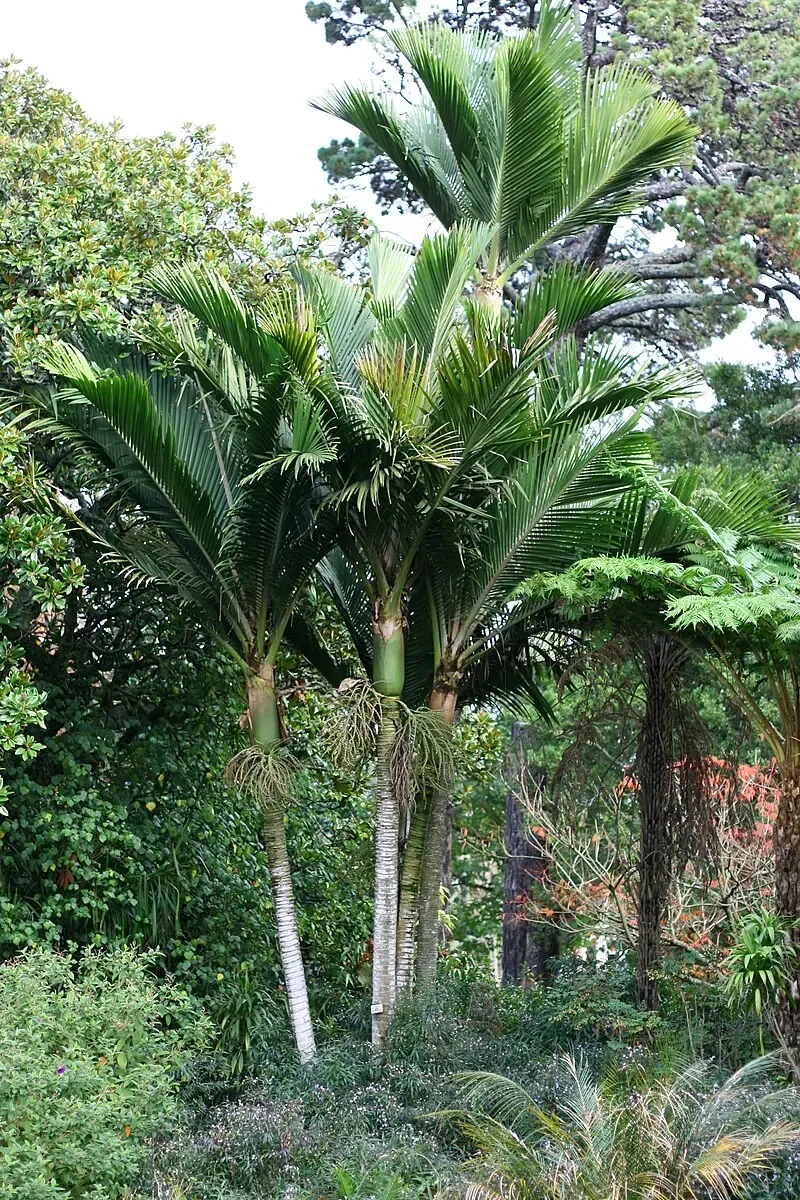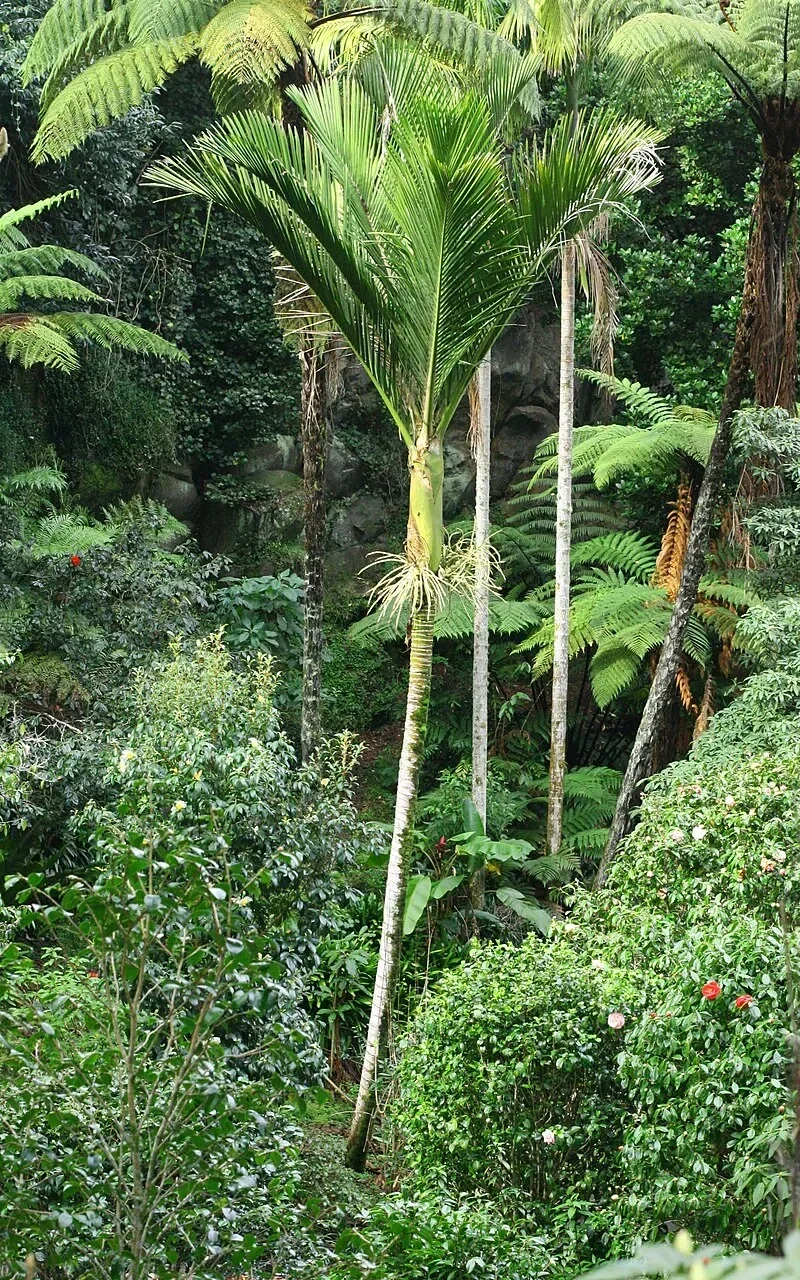
Kermadec Nīkau
Rhopalostylis baueri
Introduction
Introduction Overview
Rhopalostylis, the Kermadec nīkau, is native to the Kermadec Islands northeast of New Zealand. It is closely related to the mainland nīkau (R. sapida) but is taller, with larger fruit and longer fronds. See more NZ native palms .

Plant Description
Botanical Features
Kermadec Nīkau ( Rhopalostylis baueri ), also known as the Norfolk Island palm, is a species of palm native to Norfolk Island (Australia) and the Kermadec Islands (New Zealand). This palm can reach heights of 10 to 15 meters with a green to dark green trunk that fades to grey with age, typically around 30 to 35 cm in diameter. It features a prominent, smooth, and slightly bulging green crownshaft, which is 50-80 cm long. The pinnate leaves are dark green, 3 to 4 meters long, with closely set leaflets that can be up to 1 meter long. The inflorescence, a branched flower spike, emerges from below the crownshaft and can be 30 to 50 cm long, bearing 50 to 60 stout branches with small, pale cream-coloured flowers that can also be pink or white. Its fruits are initially green, turning a bright red when ripe, and are a favorite food of the endangered Norfolk Island parakeet. The fruit is typically subglobose to globose and about 13 x 12 mm in size.
Quick Facts
Quick Facts Overview
| Scientific Name | Rhopalostylis Baueri |
|---|---|
| Height | Up to 20 m |
| Spread | 3-4 m |
| Water Needs | Medium to high |
| Light | Partial shade to full sun |
| Frost Tolerance | Low (damaged below 0°C) |
| Salt Tolerance | High |
| Growth Rate | Moderate |
| Lifespan | Over 100 years |
Climate Best Suited to
The Kermadec nīkau is native to the subtropical Kermadec Islands and requires warm, frost-free conditions. It is best suited to coastal and lowland areas with mild winters.
Regional Suitability
| City | Climate Suitability |
|---|---|
| Whangārei | Ideal |
| Auckland | Ideal |
| Hamilton | Ideal |
| Tauranga | Ideal |
| Rotorua | Ideal |
| Gisborne | Ideal |
| New Plymouth | Ideal |
| Napier | Ideal |
| Whanganui | Ideal |
| Palmerston North | Ideal |
| Wellington | Ideal |
| Nelson | Ideal |
| Christchurch | Ideal |
| Dunedin | Ideal |
| Invercargill | Ideal |
Natural Habitat
Kermadec Nīkau ( Rhopalostylis baueri ), also known as the Norfolk Island palm, is a species of palm native to Norfolk Island (an Australian territory) and the Kermadec Islands (a New Zealand territory).
Key Habitats Include:
- Raoul Island (Kermadec Islands): On the Kermadec Islands, it is found exclusively on Raoul Island, where it is abundant in both dry and wet forest types and can sometimes be the main canopy dominant.
- Norfolk Island: On Norfolk Island, its type locality, it occupies a reduced range in the center of the island, thriving in coastal and lowland forests from sea level to 400 meters elevation.
- Sheltered Locations: It typically grows in sheltered valleys, gullies, and forest margins, benefiting from protection against strong winds and salt spray.
Preferred Conditions:
- Oceanic Island Conditions: The species has adapted to oceanic island conditions, tolerating volcanic soils and high humidity.
- Warm, Frost-Free: It requires warm, frost-free conditions, making it best suited to coastal and lowland areas with mild winters.
The presence of Rhopalostylis baueri in these specific island habitats underscores its ecological importance in contributing to the unique biodiversity and structural complexity of these isolated island ecosystems.
Plant Conservation
Rhopalostylis baueri , also known as the Norfolk Island palm or Kermadec nīkau, is native to Norfolk Island (Australia) and Raoul Island in the Kermadec Islands (New Zealand). Its conservation status varies by location. On Raoul Island (New Zealand), the species is classified as "At Risk - Naturally Uncommon" as of 2023. While it is abundant and can be a main canopy dominant in both dry and wet forest types on Raoul Island, its limited geographic range contributes to this classification. Crucially, successful rat eradication efforts on Raoul Island have allowed the palm to significantly expand its range there, and it does not face specific threats in this part of its habitat. On Norfolk Island, Rhopalostylis baueri occupies a much reduced range, primarily in the center of the island near the national park, and is considered vulnerable. The primary threats to Rhopalostylis baueri on Norfolk Island include rats, which consume the fruit and germinating seedlings, hindering natural regeneration, and invasive species like the strawberry guava ( Psidium cattleianum ), which aggressively invades the understory of primary forests. Conservation efforts include the successful eradication of rats on Raoul Island, which has greatly benefited the species there. On Norfolk Island, park staff manually remove invasive plants, but controlling the spread of species like strawberry guava remains challenging. The palm would benefit significantly from the elimination of rodents on Norfolk Island. Rhopalostylis baueri is also easily grown from fresh seeds and is cultivated in various regions globally.
Soil
Prefers rich , well-draining soil with plenty of organic matter. Avoid waterlogged or very dry sites.
Light
Partial shade to full sun. Young plants benefit from shelter.
Water
Regular watering is important for young palms. Once established , moderately drought-tolerant but benefits from consistent moisture.
Temperature
Frost-tender when young. Best in mild, coastal, or lowland climates.
Planting Guide
When to Plant
The best time to plant Rhopalostylis is during spring or autumn when soil temperatures are moderate and rainfall is reliable.
How to Plant
Dig a hole twice the width of the root ball and slightly deeper. Place Rhopalostylis in the hole, backfill with soil, and water thoroughly. Mulch around the base to retain moisture.
Ecological Role
Wildlife Interactions
Rhopalostylis plays an important ecological role in New Zealand's native ecosystems. It provides habitat and food for native wildlife and contributes to ecosystem health and biodiversity.
Uses and Significance
Garden Uses
- Rhopalostylis baueri serves as an elegant feature tree, bringing a striking subtropical aesthetic to gardens with its graceful form and impressive fronds.
- It is a valuable species for restoration planting in coastal forests, helping to re-establish native ecosystems and support local biodiversity.
- While direct traditional uses may be limited, its close relative, the mainland nīkau, has traditional significance in Māori culture, extending its general cultural importance.
Landscaping Uses
Landscaping Uses Overview
Rhopalostylis is highly valued in landscaping for its aesthetic appeal and practical benefits. It can be used in various garden styles and landscape applications.
Seasonal Care Calendar
Spring
Monitor for new frond growth and fertilize lightly. Remove any old or damaged fronds.
Summer
Water regularly during dry periods and mulch to retain soil moisture. Provide shade for young plants if needed.
Autumn
Reduce watering as temperatures drop. Remove spent fronds and tidy the plant.
Winter
Protect young palms from frost and cold winds. Minimal watering is needed, but do not let the soil dry out completely.
Pruning
Pruning Techniques
Minimal pruning is essential for Kermadec nīkau (Rhopalostylis baueri). Only remove dead, brown, or severely damaged fronds by carefully cutting them at their base. It is crucial to avoid cutting healthy green fronds, as this can weaken the palm and potentially open it to diseases, preserving its natural elegance and health.
How to Grow Kermadec Nīkau
Kermadec Nīkau ( Rhopalostylis baueri ) is a majestic palm native to the Kermadec Islands, northeast of New Zealand. It is closely related to the mainland nīkau (R. sapida) but is taller, with larger fruit and longer fronds. This elegant palm is highly valued for its ornamental appeal and its ability to thrive in warm, frost-free conditions. Its striking form, with a stout trunk and graceful, arching fronds, makes it a focal point in subtropical gardens. Understanding its propagation methods is key to successfully growing this unique species, especially for those looking to cultivate a piece of New Zealand's remote island flora.
From Seed
Propagating Kermadec Nīkau from fresh seed is the most reliable method. Collect ripe seeds from the palm when they are mature, typically in late autumn or early winter. It is crucial to clean the seeds thoroughly to remove any fleshy pulp, as this can inhibit germination. Sow the cleaned seeds in a well-draining seed-raising mix, such as a blend of sand and compost, lightly covering them. Maintain consistent moisture in the seed tray and keep it in a warm, humid environment, ideally with temperatures between 20-25°C. Germination can be slow, often taking several months, so patience is required. Once seedlings have developed a few true leaves and are stable, carefully pot them into individual tall containers, minimizing root disturbance. Grow them on in a sheltered environment with steady moisture and protection from direct sun before gradually hardening them off for planting out.
Pests and Diseases
Common Pests
Rhopalostylis is generally resistant to most pests due to its native adaptations. However, it may occasionally be affected by common garden pests such as aphids or scale insects.
Disease Prevention
To prevent diseases, ensure good air circulation around Rhopalostylis and avoid overwatering. Remove any diseased plant material promptly to prevent spread.
Cultural Significance
Traditional Uses and Values
Rhopalostylis baueri , commonly known as the Norfolk Island palm or "niau" on Norfolk Island, and the Kermadec nīkau in New Zealand, holds some cultural significance primarily through its historical uses and its connection to the broader "nīkau" palm family in New Zealand. Historically, early settlers utilized the growing tip of the Rhopalostylis baueri palm as a vegetable. It was reportedly consumed raw, where it tasted like a nut, or boiled, resembling an artichoke bottom. While specific extensive Māori cultural uses are more thoroughly documented for its close relative, Rhopalostylis sapida (the mainland nīkau), the Rhopalostylis baueri is recognized as one of New Zealand's native palms and is valued for its elegant form and ecological role. For Rhopalostylis sapida , Māori traditionally used the inner leaves and young flower clusters as food, and the heart of the palm (rito) was a delicacy. Leaves were also used for weaving items like kete (baskets) and floor mats, as well as for waterproof thatch for buildings and wrapping food for cooking. Unripe berries were eaten, and ripe berries were crafted into necklaces. Given the close relationship and shared "nīkau" designation, it is possible some of these broader cultural associations extend to Rhopalostylis baueri , particularly for the Kermadec Islands population.
Bonus Tip
Expert Growing Advice
Kermadec nīkau ( Rhopalostylis baueri ) appreciates summer humidity. Group plant with groundcovers to shade the root zone and mist fronds in the evening during hot spells to keep the crownshaft glossy and pest-free.







